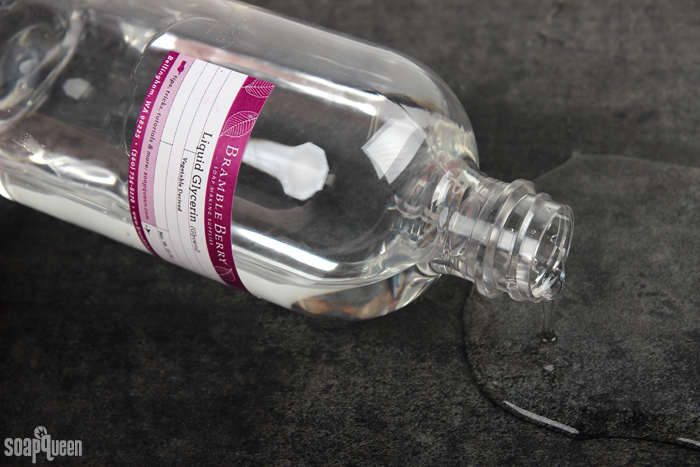
Glycerin is a thick, clear fluid that is used in a wide variety of bath and beauty products. It is a humectant, which means it has the ability to attract moisture in the air to the skin. This ability makes it great for lotions, soaps and other products. In addition to the bath and beauty industry, glycerin is used in the food industry as a sweetener. Outside the United States, it is commonly referred to as glycerol.
Glycerin is a major ingredient in melt and pour soap bases. In fact, some refer to melt and pour soap as “glycerin soap.” The large amount of glycerin is one of the reasons why melt and pour soap feels great on the skin. Adding extra glycerin to the soap softens the base. This is great if you want a bendable texture. For example, in the Melt & Pour Soap Ribbon Tutorial, additional glycerin gives soap the flexibility to create ribbons. The moldable texture also comes in handy in the Candy Cane Soap Tutorial, and the Embedded Melt & Pour Jellyroll Soap.
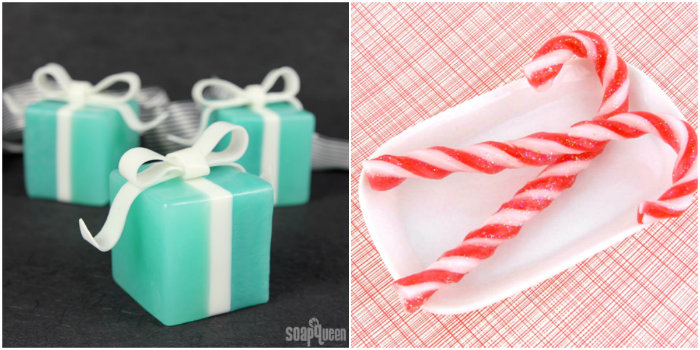 Left to right: Melt and Pour Soap Ribbons, Candy Cane Soap
Left to right: Melt and Pour Soap Ribbons, Candy Cane Soap
Because glycerin attracts moisture from the air, it can cause melt and pour soap to “sweat.” This sweat is known as glycerin dew. Learn more about glycerin dew and how to prevent it in this post. In cold process soap, glycerin is a naturally occurring by-product of the saponification process. If the soap gets too hot, the glycerin can congeal which leads to glycerin rivers (shown below). Glycerin rivers are not harmful in any way, but they are a cosmetic issue. Click here to learn more about glycerin rivers and how to prevent them.
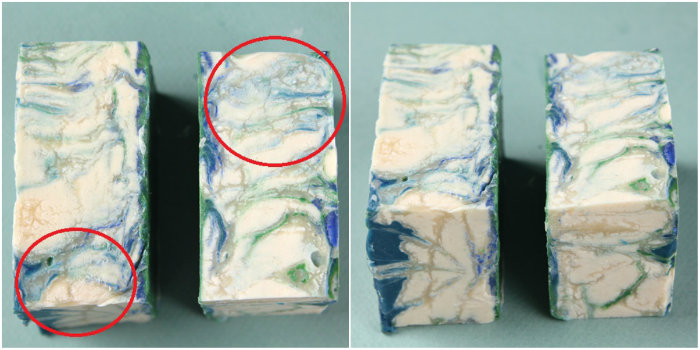 When cold process soap gets hot, the glycerin can congeal into “glycerin rivers.”
When cold process soap gets hot, the glycerin can congeal into “glycerin rivers.”
Glycerin adds humectant properties to lotion as well. Because it’s a water soluble product, glycerin is added to the water stages of lotion making. Glycerin is a major ingredient in many of the Bramble Berry Lotion Bases. To learn more about the difference between the bases and how to use them, check out this blog post. The bases are a great option if creating your own lotion recipe seems intimidating, or if you’re looking for an easy project. Click here to learn more about making you own lotion recipes from scratch.
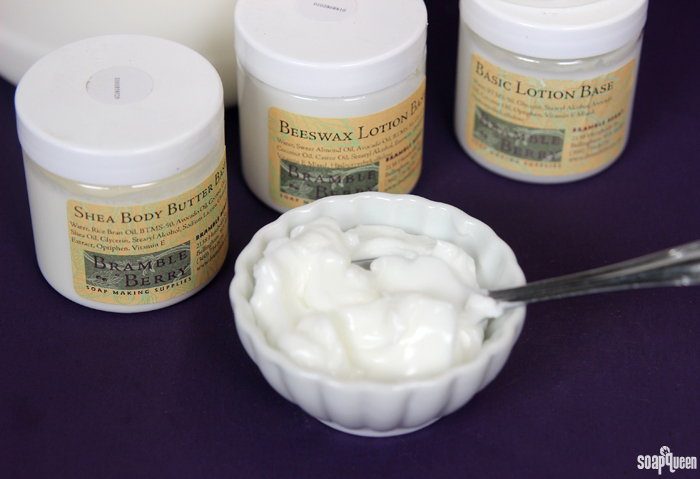 Glycerin is a common ingredient in lotion, including the Bramble Berry Lotion Bases.
Glycerin is a common ingredient in lotion, including the Bramble Berry Lotion Bases.
If you’re looking for lotion recipes that contain glycerin, check out the Rose & Aloe In-Shower Lotion Tutorial. The lotion is applied before you leave the shower. Glycerin is also used in the Argan & Shea Lotion, which contains luxurious argan oil. If you prefer a light lotion texture, the Rose Water Lotion has a mixture of glycerin and lightweight oils.
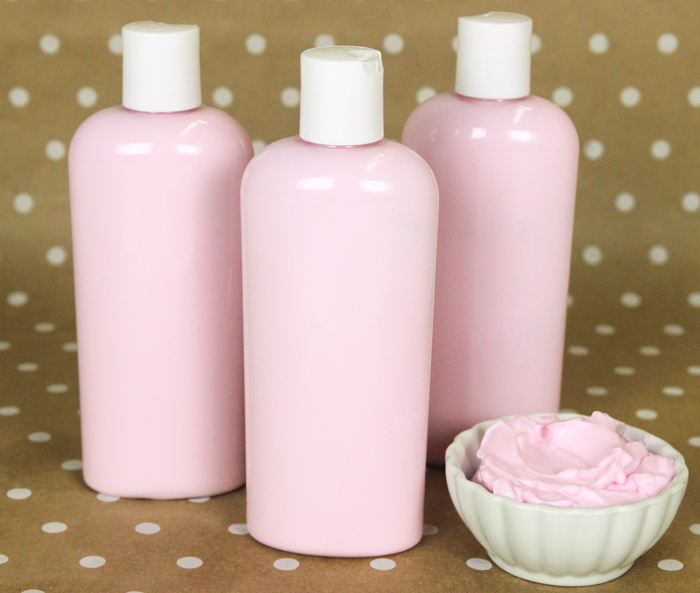 In the Rose & Aloe In-Shower Lotion Tutorial, glycerin adds humectant properties.
In the Rose & Aloe In-Shower Lotion Tutorial, glycerin adds humectant properties.
Glycerin is one of the main ingredients in my Solid Bubble Bath recipe. The glycerin helps create the moldable texture that allows the bars to be rolled. Check out this Soap Queen TV episode to see the recipe in action. The Lovespell Solid Bubble Bath DIY puts a girly spin on the recipe, with lots of glitter and a pink and purple color scheme.
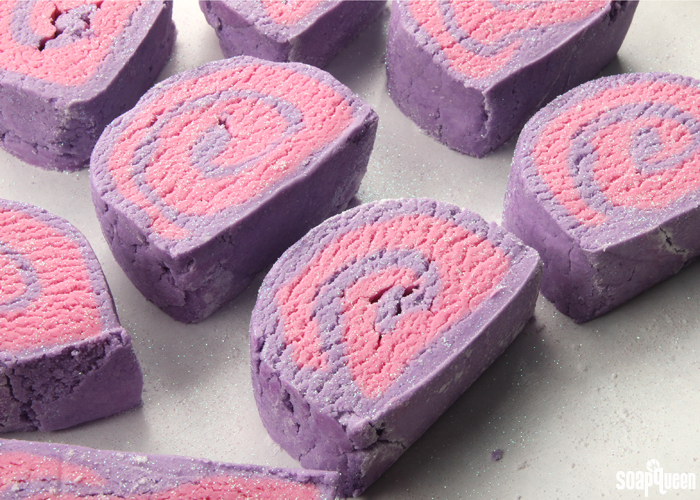 The Lovespell Solid Bubble Bath contains glycerin to give it a moldable texture.
The Lovespell Solid Bubble Bath contains glycerin to give it a moldable texture.
Glycerin can also be added to scrubs and masks. In the Easy DIY Cranberry Sugar Scrub, glycerin is added to give the scrub humectant properties. The Rose Clay Foot Mask is comprised of primarily glycerin and clays to create a spreadable, thick texture.
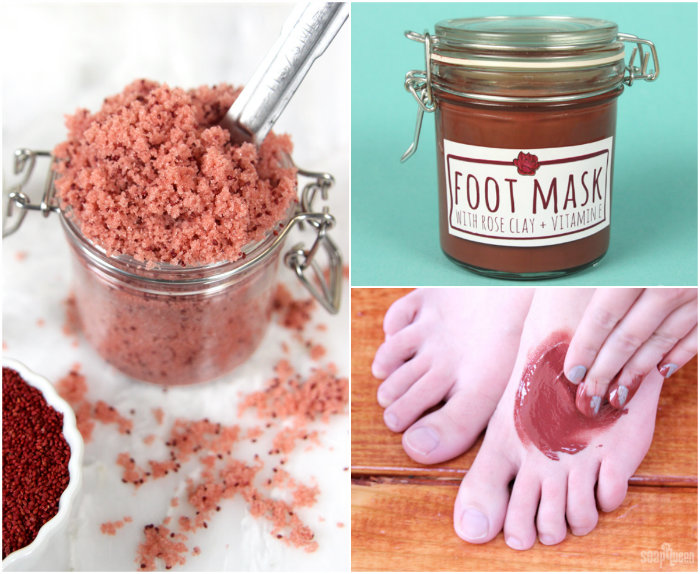 Left, clockwise: Easy DIY Cranberry Sugar Scrub, Rose Clay Foot Mask
Left, clockwise: Easy DIY Cranberry Sugar Scrub, Rose Clay Foot Mask
What is your favorite way to use glycerin? It’s such a versatile product!

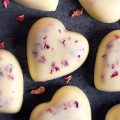
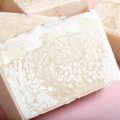


Can I add glycerin to my soap recipe for extra moisturizing? I know cold processed soap has natural glycerins on it. But i wanted to add for extra moisture. If yes, how much do you suggest per pound of soap? Thanks and Have a Great Day! 😘
We don’t recommend extra glycerin in cold process soap as it can create glycerin rivers. You can add castor oil if you like. At 2-5% it adds lather and moisture to your recipe. You may also try reducing the coconut oil and increasing the olive oil. If it’s used at more than 30%, it can feel drying on the skin. Learn more about that here: https://www.soapqueen.com/bath-and-body-tutorials/tips-and-tricks/sunday-night-spotlight-coconut-oil/
Remember to run your recipe through the Lye Calculator after any substitutions: https://www.brambleberry.com/Pages/Lye-Calculator.aspx
-Kelsey with Bramble Berry
Can you substitute glycerine in the bubble bars? If so with what? Ty
If you want to substitute any ingredients in the recipe, it will change the texture of the dough. Changes to the recipe can affect how long you have to work with the dough, how firm the bars become, how easily the bars can be rolled and cut, how it behaves in the tub, etc. In general, we don’t recommend making substitutions for the dry and wet ingredients in the recipe. If you do want to tweak the recipe, consider making a smaller batch with one color to see how the changes affect the texture of the dough and results in the tub.
-Kelsey with Bramble Berry
Solid Bubble Bath: https://www.soapqueen.com/bath-and-body-tutorials/lovespell-solid-bubble-bath-diy/
Hi I was wondering if I could use glycerin as a sweetener in lip balm, and if so, how would I incorporate it into my base (making from scratch), and at what usage rate? Thanks so much!
Incorporating glycerin in lip balm may be tricky. Because it’s water soluble, it won’t mix into the waxes and oils. It would need an emulsifier. We don’t carry a lip-safe emulsifier, so you may want to check teachsoap.com/forum to see if someone there knows where to find one. 🙂
You can also use the Lip Smacking Sweet Flavor Oil! It mixes in easily. You can use that at 1-3% with another oil or 6% on its own. Read more about flavor oils here: https://www.soapqueen.com/bramble-berry-news/sunday-night-spotlight-flavoring-oils/
Lip Smacking Sweet Flavor Oil: https://www.brambleberry.com/Lip-Smacking-Sweet-Flavor-Oil-P4679.aspx
-Kelsey with Bramble Berry
Thanks Kelsey! I’ve been looking for a sweetener that is natural, vegan, and not stevia (I have an allergy) and I was really hoping gylcerin might be the trick. I’ve never worked with it before so I didn’t realize it wasn’t oil solvable. Emulsification in a lip balm seems like too much work lol. I’ll keep searching!
You may try powdered sugar! It don’t know if it will dissolve in the oil, but if you pour the balm around 125-130F it should suspend evenly. It may give the balm a bit of texture, so you’ll want to add a small amount and make a test batch to see what you think. 🙂
-Kelsey with Bramble Berry
I was wondering if you could make a tutorial on how to make colored glycerin rivers as pictures above. I really love them and would actually like to achieve that look for some of my soap. Thanks so much! You are the best and have the best tutorials!
It’s hard to tell you exactly how to get glycerin rivers because they’re something we usually avoid! Typically, we find they happen most when we’re using titanium dioxide mixed in water and the soap is insulated so it gets really hot. I would recommend starting there. 🙂
Read more about glycerin rivers here: https://www.soapqueen.com/bath-and-body-tutorials/tips-and-tricks/river-runs-deep-explanation-glycerin-rivers/
-Kelsey with Bramble Berry
where can I buy all the ingredients?
You can find all the ingredients on BrambleBerry.com! We sell supplies to make lotion, soap, lip balm, etc. 🙂
You may like these kits, which come with everything you need to make projects: https://www.brambleberry.com/Kits-and-Samplers-C203.aspx
-Kelsey with Bramble Berry
My shave soap has glycerin added as part of the superfat at the end of the cook. I also use it to disperse all of my colorants so they’re compatible with both CP/HP & melt & pour soap
Glycerin in shaving soap sounds amazing! It’s great for moisturizing the skin. 🙂
-Kelsey with Bramble Berry
I can’t take the credit for this, I learned it from soaping101.com but using glycerin in place of water works great for making liquid soap. Making liquid soap requires potassium hydroxide instead of sodium hydroxide and using potassium hydroxide takes A LONG time to trace, but heating your glycerin slowly to 200, mixing in your potassium hydroxide causes trace sometimes in seconds.
That’s awesome James, thanks so much for the tip! 🙂
-Kelsey with Bramble Berry